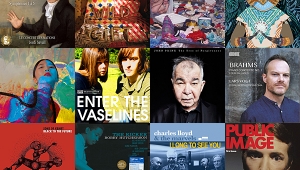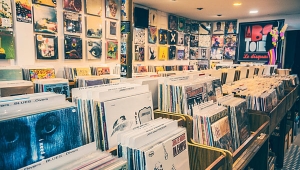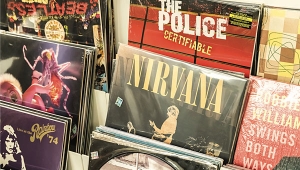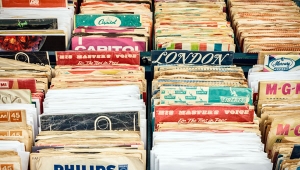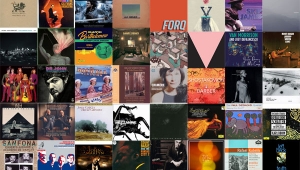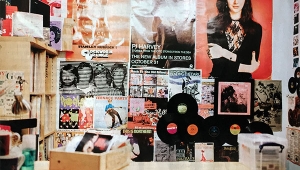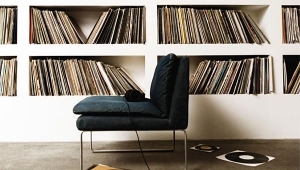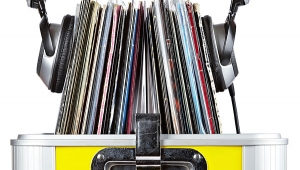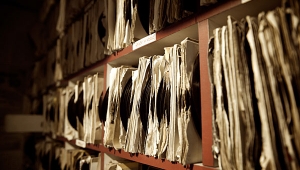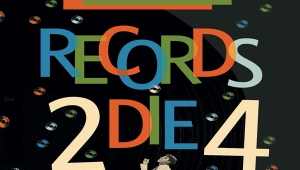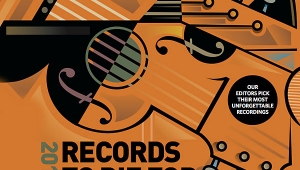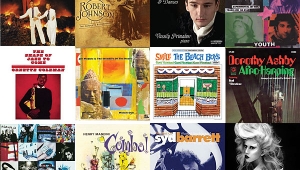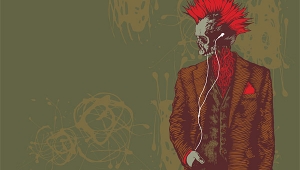| Columns Retired Columns & Blogs |
1991 Records To Die For Page 7
Beth Jacques
MARIANNE FAITHFULL: Broken English
Island 842 355-1 (LP), -2 (CD). Mark Miller Mundy, prod. AAA/AAD. TT: 32:48
Produced by then-contemporary punker Mark Mundy, Broken English exemplifies what simple analog production, acoustic instruments, and committed, no-frills vocal interpretation can deliver. Anyone who's been around can identify with Faithfull's stark interpretation of material from Shel Silverstein ("The Ballad of Lucy Jordan") and John Lennon ("Working Class Hero") to her own bitter pills arguing for better communication between classes, countries, sexes, and various facets of the self. An adult album, and at one end of the bell curve of broken understandings, there's a track with lyrics from writer Heathcote Williams so vicious and so true that if the Moralistic Minority paid attention to music rather than the color of a rapper's skin, "Why D'Ya Do It" would have been pulled before "Tipper Stickers" were a gleam in Zappa's eye.
MICHAEL JACKSON: Thriller
Epic QE-38112 (LP), EK-38112 (CD). Quincy Jones, prod.; Bruce Swedien, Matt Forger, engs. DDA/DDD. TT: 42:24
"Michael's not 'black,' Michael's just...Michael," blurted an activist recently pressured to choose art or politics. No one disrespects genius, apple pie, or Captain Eo. His social conscience may echo Spike Lee, but the soul provides the sugar that makes the medicine go down. Here the Gloved One does more for harmony, self-respect, and the terminally uncoordinated on the dance floor than Aretha, Freud, and the United Colors of Benetton. "Billie Jean," for instance, is the perfect pop single: the most flawless examination of personal responsibility since Dostoyevsky set to a dance beat and composition as exquisite as Lakmé's "Bell Song." Orchestrated by production's Grand Master Flash Quincy Jones, every instrument is where it should be and the sound as recorded (and reproduced) is more pure than the top of a mountain (listen for the separation in "Thriller"). With guests ranging from metal guitarist Eddie Van Halen through pop icons like Paul McCartney, each track is infused with love, craft, a sly sense of humor, and Michael's perfect, perfectly versatile vocal control. Best bonus: He may testify, but he don't preach.
PINK FLOYD: The Dark Side of the Moon
Harvest CDP 7 460012 (CD only). Pink Floyd, prod. Alan Parson, eng. AAD. TT: 42:58
An artistic reconstruction of the dark night of the bad trip that haunted MIA founder-member Syd Barrett and reverberated down the corridors of every track subsequently laid down by Britain's pioneers of acid rock. Floyd's early grasp of synthesized techniques, use of a 360° "azimuth co-ordinated" sound system live, and equivalently obsessive attention to the niceties of studio recording make manifest the conflict between the worlds of nature and artifice (the album's opening heartbeat rising from an audible region we're not supposed to be able to "hear" is as eerie an intro as you'll ever experience). A true tribute from four artists to another, Floyd turns biography into something more like metaphysics. (XI-9)
ROLLING STONES: Get Yer Ya-Ya's Out!
London/Abkco 8005-1 (LP), -2 (CD). Rolling Stones/Glyn Johns, prod.; Glyn Johns, eng. AAA/AAD-ADD. TT: 47:54
Live is live, and recorded sound is something else. But this combination of terrific performance plus live-in-concert recording made the 1969 Get Yer Ya-Ya's Out! the only rock LP an audiophile professional jazz drummer pal could ever stomach. It's the perfect combination of originals like "Midnight Rambler," teenage braggadocio, and a stylistic wash of R&B. Best of all, material like "Sympathy for the Devil" is free from the overproduction or contempt for mix technology with which most Stones LPs are infected. Jagger & Co. connect with concert snap; the selection of material is definitive, and producer emeritus Glyn Johns, who recorded and mixed in the Wally Heider mobile (complete with dirty Ampeg amps), caught it clean and like it was.
STEELY DAN: Aja
MCAD-37214 (CD only). Gary Katz, prod. ADD. TT: 39:59
More a concept than a band, Steely Dan's quintessential work is its penultimate album. An expression of an economical, mysterious, and original voice, Steely Dan began to exit stage left in 1977 with an LP whose technical sound matched its creative sense: Aja won a Grammy for Best-Engineered Album of 1978. It's a flawless recording, featuring peerless capture of instrumental tone and incomparable stereo separation. Sidemen include jazz-ish guitarists Larry Carlton and Lee Ritenour, and tenor sax Tom Scott. Not really accessible to criticism or analysis, Aja embodies the sensibility and feel of a foreign film. Seminal tracks like "Deacon Blues" provide material with depth that rewards each revisit, like a poem. Or a prayer.

Barbara Jahn
BENJAMIN: Antara
BOULEZ: Dérive, Memoriale
HARVEY: Song Offerings
Penelope Walmsley-Clarke, soprano; Sebastian Bell, flute; George Benjamin, London Sinfonietta
Nimbus NI 5167 (CD only). DDD. TT: 49:48
At 30, George Benjamin is already one of England's most respected composers. Antara was written in answer to a commission from Boulez to commemorate the tenth anniversary of his Institut pour la Recherche et la Coordination Acoustique-Musique (IRCAM), at which both Benjamin and Jonathan Harvey have worked. It is a beautiful work, synthesizing "a whole world of panpipe sonorities through the agency of IRCAM's pride and joy, the 4X computer." Boulez's own short pieces make an apt coupling, and the disc is rounded off, by complete contrast, with Harvey's "conventional" song cycle for soprano and eight instruments in an exquisite account of Rabindranath Tagore's sensuous poetry. Acoustics vary with venue, but results are equally superb.
MOZART: Sonata for 2 Pianos, K.448
SCHUBERT: Fantasia for Piano Duet, Op.103
Radu Lupu, Murray Perahia, pianos
CBS IM-39511 (LP), MK-39511 (CD). Bob Auger, eng.; Andrew Kazdin, prod. DDA/DDD. TT: 42:08
This disc takes my breath away every time I hear it. As individual artists, Lupu and Perahia are impeccable; together they are ineffable. I cannot think of any other pianists who consistently have the same range and delicacy of touch or a more intuitive grasp of dynamic structure; here they imbue these miniature masterpieces with a degree of passion that commands concentration. The recording was made live at The Maltings, Snape, England, but happily there is no audience noise to distract. Pity about the poor TT.
PURCELL: The Fairy Queen
Argenta, Dawson, Daniels, Fouchécourt, Loonen, Randle, Lander, Deletré, Les Arts Florissants, William Christie
Harmonia Mundi HMC 1308.9 (2 CDs only). Michel Bernard, eng.; Madeleine Sola, prod. DDD. TT: 2:08:42
The sheer joy and sparkle of this delightful recording, its wit and vitality, and the exotic battery of sounds from theorbos, baroque guitar, gamba, harpsichords, organ, and authentic wind, brass, and strings, would surely win over even the most hardened of the anti-period performance lobby. Christie's long associations with Les Arts Florissants and Harmonia Mundi show in the quality of both performance and recording achieved here. (XIII-9)
THERE IS SWEET MUSIC: English Choral Songs, 1890-1950
John Rutter/The Cambridge Singers
Collegium COLCD 104 (CD only). Campbell Hughes, eng.; Jillian White, prod. DDD. TT: 56:20
I would still consider one four-minute snippet of a cappella singing on this disc, in Stanford's "The Blue Bird," the most hauntingly beautiful performance/recording I have ever heard. The control of this small, mixed-voice choir over all musical parameters is quite unbelievable, and this tiny record label, set up especially to record their performances, has captured the essence of their unique qualities to perfection. Friends come to my home to listen to this disc (and, subsequently, all have bought it)---to once let it go would mean never to hear it again!
JOHN WILLIAMS: Spirit of the Guitar: Music of the Americas
John Williams, guitar
CBS MK 44898 (CD only). Mike Stavrou, eng.; Mike Stavrou, John Williams, prods. ADD. TT: 53:52
John Williams went to great and heightened lengths to explain (try to explain!) to me in interview just why he dislikes digital recording; as a consequence of his view, his solo albums are now recorded in analog, using Dolby SR, and are converted to the digital master for CD via the front end of a DAT machine. Though I didn't fully understand the words behind his theories, my ears tell me that he has found a wonderfully faithful means of reproducing the idiomatic colors, timbre, and spirit of the guitar. Such an immediate and fresh recording couldn't help but capture the vast range of nuance and attack that Williams has at his fingertips, and though not all this music can be considered equally memorable, the opening number alone, Andrew York's Sunburst, is worth the price of the disc.

Ken Kessler
Richard Lehnert said it, not I: "Each recommended recording should be tops in both performance and sound"---which creates something of a dilemma for me. It also points out a fundamental difference between classical and the various "nonclassical" forms, a difference which has nothing whatsoever to do with "one being superior to the other."
MARIANNE FAITHFULL: Broken English
Island 842 355-1 (LP), -2 (CD). Mark Miller Mundy, prod. AAA/AAD. TT: 32:48
Produced by then-contemporary punker Mark Mundy, Broken English exemplifies what simple analog production, acoustic instruments, and committed, no-frills vocal interpretation can deliver. Anyone who's been around can identify with Faithfull's stark interpretation of material from Shel Silverstein ("The Ballad of Lucy Jordan") and John Lennon ("Working Class Hero") to her own bitter pills arguing for better communication between classes, countries, sexes, and various facets of the self. An adult album, and at one end of the bell curve of broken understandings, there's a track with lyrics from writer Heathcote Williams so vicious and so true that if the Moralistic Minority paid attention to music rather than the color of a rapper's skin, "Why D'Ya Do It" would have been pulled before "Tipper Stickers" were a gleam in Zappa's eye.
MICHAEL JACKSON: Thriller
Epic QE-38112 (LP), EK-38112 (CD). Quincy Jones, prod.; Bruce Swedien, Matt Forger, engs. DDA/DDD. TT: 42:24
"Michael's not 'black,' Michael's just...Michael," blurted an activist recently pressured to choose art or politics. No one disrespects genius, apple pie, or Captain Eo. His social conscience may echo Spike Lee, but the soul provides the sugar that makes the medicine go down. Here the Gloved One does more for harmony, self-respect, and the terminally uncoordinated on the dance floor than Aretha, Freud, and the United Colors of Benetton. "Billie Jean," for instance, is the perfect pop single: the most flawless examination of personal responsibility since Dostoyevsky set to a dance beat and composition as exquisite as Lakmé's "Bell Song." Orchestrated by production's Grand Master Flash Quincy Jones, every instrument is where it should be and the sound as recorded (and reproduced) is more pure than the top of a mountain (listen for the separation in "Thriller"). With guests ranging from metal guitarist Eddie Van Halen through pop icons like Paul McCartney, each track is infused with love, craft, a sly sense of humor, and Michael's perfect, perfectly versatile vocal control. Best bonus: He may testify, but he don't preach.
PINK FLOYD: The Dark Side of the Moon
Harvest CDP 7 460012 (CD only). Pink Floyd, prod. Alan Parson, eng. AAD. TT: 42:58
An artistic reconstruction of the dark night of the bad trip that haunted MIA founder-member Syd Barrett and reverberated down the corridors of every track subsequently laid down by Britain's pioneers of acid rock. Floyd's early grasp of synthesized techniques, use of a 360° "azimuth co-ordinated" sound system live, and equivalently obsessive attention to the niceties of studio recording make manifest the conflict between the worlds of nature and artifice (the album's opening heartbeat rising from an audible region we're not supposed to be able to "hear" is as eerie an intro as you'll ever experience). A true tribute from four artists to another, Floyd turns biography into something more like metaphysics. (XI-9)
ROLLING STONES: Get Yer Ya-Ya's Out!
London/Abkco 8005-1 (LP), -2 (CD). Rolling Stones/Glyn Johns, prod.; Glyn Johns, eng. AAA/AAD-ADD. TT: 47:54
Live is live, and recorded sound is something else. But this combination of terrific performance plus live-in-concert recording made the 1969 Get Yer Ya-Ya's Out! the only rock LP an audiophile professional jazz drummer pal could ever stomach. It's the perfect combination of originals like "Midnight Rambler," teenage braggadocio, and a stylistic wash of R&B. Best of all, material like "Sympathy for the Devil" is free from the overproduction or contempt for mix technology with which most Stones LPs are infected. Jagger & Co. connect with concert snap; the selection of material is definitive, and producer emeritus Glyn Johns, who recorded and mixed in the Wally Heider mobile (complete with dirty Ampeg amps), caught it clean and like it was.
STEELY DAN: Aja
MCAD-37214 (CD only). Gary Katz, prod. ADD. TT: 39:59
More a concept than a band, Steely Dan's quintessential work is its penultimate album. An expression of an economical, mysterious, and original voice, Steely Dan began to exit stage left in 1977 with an LP whose technical sound matched its creative sense: Aja won a Grammy for Best-Engineered Album of 1978. It's a flawless recording, featuring peerless capture of instrumental tone and incomparable stereo separation. Sidemen include jazz-ish guitarists Larry Carlton and Lee Ritenour, and tenor sax Tom Scott. Not really accessible to criticism or analysis, Aja embodies the sensibility and feel of a foreign film. Seminal tracks like "Deacon Blues" provide material with depth that rewards each revisit, like a poem. Or a prayer.
Barbara Jahn
BENJAMIN: Antara
BOULEZ: Dérive, Memoriale
HARVEY: Song Offerings
Penelope Walmsley-Clarke, soprano; Sebastian Bell, flute; George Benjamin, London Sinfonietta
Nimbus NI 5167 (CD only). DDD. TT: 49:48
At 30, George Benjamin is already one of England's most respected composers. Antara was written in answer to a commission from Boulez to commemorate the tenth anniversary of his Institut pour la Recherche et la Coordination Acoustique-Musique (IRCAM), at which both Benjamin and Jonathan Harvey have worked. It is a beautiful work, synthesizing "a whole world of panpipe sonorities through the agency of IRCAM's pride and joy, the 4X computer." Boulez's own short pieces make an apt coupling, and the disc is rounded off, by complete contrast, with Harvey's "conventional" song cycle for soprano and eight instruments in an exquisite account of Rabindranath Tagore's sensuous poetry. Acoustics vary with venue, but results are equally superb.
MOZART: Sonata for 2 Pianos, K.448
SCHUBERT: Fantasia for Piano Duet, Op.103
Radu Lupu, Murray Perahia, pianos
CBS IM-39511 (LP), MK-39511 (CD). Bob Auger, eng.; Andrew Kazdin, prod. DDA/DDD. TT: 42:08
This disc takes my breath away every time I hear it. As individual artists, Lupu and Perahia are impeccable; together they are ineffable. I cannot think of any other pianists who consistently have the same range and delicacy of touch or a more intuitive grasp of dynamic structure; here they imbue these miniature masterpieces with a degree of passion that commands concentration. The recording was made live at The Maltings, Snape, England, but happily there is no audience noise to distract. Pity about the poor TT.
PURCELL: The Fairy Queen
Argenta, Dawson, Daniels, Fouchécourt, Loonen, Randle, Lander, Deletré, Les Arts Florissants, William Christie
Harmonia Mundi HMC 1308.9 (2 CDs only). Michel Bernard, eng.; Madeleine Sola, prod. DDD. TT: 2:08:42
The sheer joy and sparkle of this delightful recording, its wit and vitality, and the exotic battery of sounds from theorbos, baroque guitar, gamba, harpsichords, organ, and authentic wind, brass, and strings, would surely win over even the most hardened of the anti-period performance lobby. Christie's long associations with Les Arts Florissants and Harmonia Mundi show in the quality of both performance and recording achieved here. (XIII-9)
THERE IS SWEET MUSIC: English Choral Songs, 1890-1950
John Rutter/The Cambridge Singers
Collegium COLCD 104 (CD only). Campbell Hughes, eng.; Jillian White, prod. DDD. TT: 56:20
I would still consider one four-minute snippet of a cappella singing on this disc, in Stanford's "The Blue Bird," the most hauntingly beautiful performance/recording I have ever heard. The control of this small, mixed-voice choir over all musical parameters is quite unbelievable, and this tiny record label, set up especially to record their performances, has captured the essence of their unique qualities to perfection. Friends come to my home to listen to this disc (and, subsequently, all have bought it)---to once let it go would mean never to hear it again!
JOHN WILLIAMS: Spirit of the Guitar: Music of the Americas
John Williams, guitar
CBS MK 44898 (CD only). Mike Stavrou, eng.; Mike Stavrou, John Williams, prods. ADD. TT: 53:52
John Williams went to great and heightened lengths to explain (try to explain!) to me in interview just why he dislikes digital recording; as a consequence of his view, his solo albums are now recorded in analog, using Dolby SR, and are converted to the digital master for CD via the front end of a DAT machine. Though I didn't fully understand the words behind his theories, my ears tell me that he has found a wonderfully faithful means of reproducing the idiomatic colors, timbre, and spirit of the guitar. Such an immediate and fresh recording couldn't help but capture the vast range of nuance and attack that Williams has at his fingertips, and though not all this music can be considered equally memorable, the opening number alone, Andrew York's Sunburst, is worth the price of the disc.
Ken Kessler
Richard Lehnert said it, not I: "Each recommended recording should be tops in both performance and sound"---which creates something of a dilemma for me. It also points out a fundamental difference between classical and the various "nonclassical" forms, a difference which has nothing whatsoever to do with "one being superior to the other."
It's like this: I cannot, no matter how hard I try, find even five recordings which are unreservedly recommendable using both criteria. There are plenty of great-sounding recordings with negligible musical worth, and just as many brilliant performances with severely flawed sonics. With classical, you get a choice; with nonclassical, you don't.
Let's say you're looking for a flawless LP or CD of Mozart's whatever. You could have dozens or even hundreds of releases from which to choose. You just keep looking until you find one in which the performance and the recording are five-star. With nonclassical, you're buggered. You want Howard Tate's musically perfect debut LP, Get It While You Can? Then be prepared for noise, break-up, and the kind of stereo which made EMI release the Beatles' first four in mono. You fancy some late-1970s title on WEA? Then expect an Aphex Aural Exciter. Nonclassical releases are one-offs, with remakes few and far between and rarely worth considering; you're stuck without options. With classical, they're allowed to do it again and again until they get it right.
Unfortunately, none of the music which I consider to be the stuff I'd take to a desert island has sound quality worthy of inclusion in Stereophile's list, while those which do have state-of-the-art sound quality are musically flawed. Sure, I could rattle off a list of titles like the Persuasions' We Came to Play or Billy Cotton's Wakey Wakey, but they're so "genre specific" that it would seem almost presumptuous to recommend them. Never have I suggested that my tastes should be forced upon others, however much I hate classical and adore soul; for a list such as this, I would assume that the breadth of the appeal of the titles should be greater than that of Root Boy Slim & The Sex Change Band's eponymous debut or Kevin Ayers's Bananamour.
Neither do I want to recommend specific tracks, and singles are deleted faster than a new model from Japan Inc.; I am not going to incite riots in secondhand shops by telling you to look for the 12" version of Willy de Ville's "Assassin of Love," or Eddy Grant's "Can't Get Enough" [Yeah!---Ed.] Some LPs, such as Lou Rawls's At Last, may seem to make the grade, but then I have to admit that maybe there's a touch too much close miking. I can tear apart any LP I adore if I listen closely enough. And that raises another point.
The mere concept of a list of recommended recordings bothers me in myriad ways when it's applied to nonclassical because it automatically precludes some of the greatest music of all time. By default, it means that much of limited worth qualifies for this listing because of hot sonics, and I shudder to think how many people own Supertramp and Dire Straits LPs just because of the sound quality. Worse, I find it odious that anyone could place sonics on the same plane as the music itself. That's for hi-fi nuts, not music lovers. So, to torment all of you, I'm going to recite my personal choices of the five greatest nonclassical stereo LPs of all time: Howard Tate's Get It While You Can, Buffalo Springfield's Again, Sam & Dave's I Thank You, the Rolling Stones' Let It Bleed, and Mel & Tim's Starting All Over Again. And you know what? In sonic terms, they're all dogshit.
- Log in or register to post comments

